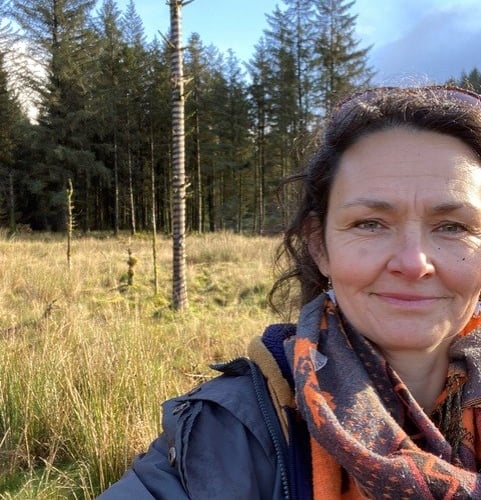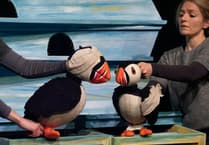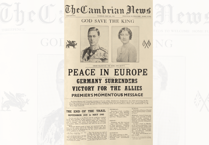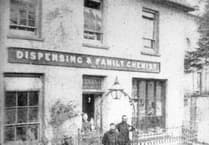Ceredigion Museum will hosts a series of free workshops to explore the first connection between Ireland and Wales and Mesolithic life in Cardigan Bay.
This will form part of a jam-packed programme of performances and workshops in Aberystwyth as part of Portalis, a cross-border project led by South East Technological University (SETU) in Ireland.
Dating back to the Mesolithic period about 10,000 years ago, visitors have until 24 June to learn how those first settlers adapted to their surroundings to survive. The project also seeks to understand if there are any parallels with how we can adapt to climate change now.
It was between 11,000 and 6,000 years ago, after the last ice age, that the coastline of Cardigan Bay became what we know today. As the ice melted the sea level rose. Sand and pebble beaches became rocky shorelines. Salt water gradually encroached into low-lying land and river estuaries. Habitats changed, plant species altered, and the seasonal migratory paths of animals and birds shifted.
Artist Billie Ireland, a former Aberystwyth University student and visual artist will hold a series of workshops at the museum.

Carrie Canham, Ceredigion Museum curator, said Billie “is drawn to spiritual, ritualistic and sacrificial methods of creation, often reflecting on the power of motherhood and connection to place. She makes temporary land interventions, slow vertical format films and charcoal sculpture that reveal Transformation and Transience.
“Billie is interested in Anthracology or charcoal science and how art might enable a new paradigm shifting and sacred connection to carbon. It is an expanding and relevant subject at a juncture with many traditions and disciplines, yet artists are often excluded from this conversation.
"Organic charcoal stores information on past human cultures, environments, climate, and contributes to future developments of agriculture (Terra Preta) or carbon sequestration, biochar technology (storing carbon for the future). It fuelled humanities rapid progress and is still essential in our technological development today.”
Cllr Catrin M S Davies, cabinet member for culture, leisure and customer services said: “It’s a pleasure to be able to welcome Billie Ireland to share her talents in these workshops. I would encourage people to take advantage of this opportunity to learn more about her and what inspires her, and see the techniques and her medium of painting, which underpins her work.”
From 10.30am-12.30pm and 1.30pm-3.30pm on 27 May and 17 June, two family workshops will be held. Children are to be accompanied by an adult and participants should be prepared to get a bit messy as they will be using charcoal, chalk and ochre to make Mesolithic magic with sticks, stones, feathers and bones.
Billie Ireland said the workshops will include “drawing fun with natural and ancient materials to discover the Mesolithic world and connect to today’s threatened flora and fauna, participants will also make their own brushes and mark making tools from found and gathered materials". People "will explore marks, symbols and motifs past and present using charcoal, ochre, chalk and bone. Bringing everyone's creations together, a sculptural offering will be made to the powerful elements of land, sky and sea and to connect through materials amidst the climate crisis,” she added.
Pre-school age family workshops for children and their parents/carers will take place on 13 June from 11am-12pm and 1pm-2pm.
Billie continued: “Once again, prepare to get a bit messy as the same materials will be used. The workshop offers sensory creative fun with natural materials. Play with wood, seeds, stones and clay to wrap, thread, balance and stack, using Mesolithic animals, nests and shelters as inspiration.”
Family workshops of a musical kind will be held on 1 June between 10am and 12pm and 1pm and 3pm with the Mesolithic Orchestra. Explore the sounds of Mesolithic times, create instruments and perform in a Mesolithic orchestra with sound artist, Tim Beckham.
On 3 June, there will be two opportunities to see a dance inspired by the Portalis project at 3pm and 6pm. The dance collective Sandpaper & Mash, made up of dancers Friederike Anna Zinn and Alexandra Bierlaire and featured in the video above, explore the journey of migration between Wales and Ireland taking experiences from personal stories of travelling round Europe. Finding the curiosity in moving, seeing and settling within today's society, the dance reminisces on the same journey that our ancestors took over thousands of decades.
The events can be booked via the following links:
- 27 May, 10.30am: www.eventbrite.com/e/633571127297
- 27 May, 1.30pm: www.eventbrite.com/e/633843321437
- 1 June, 10.00am: www.eventbrite.com/e/633847584187
- 1 June, 1pm: www.eventbrite.com/e/633848607247
- 3 June, 3pm: www.eventbrite.com/e/633848837937
- 3 June, 6pm: www.eventbrite.com/e/633850252167
- 13 June, 11am: www.eventbrite.com/e/633845688517
- 13 June, 1pm: www.eventbrite.com/e/633846902147
- 17 June, 10.30am: www.eventbrite.com/e/633843943297
- 17 June, 1.30pm: www.eventbrite.com/e/633844083717
For more information on events at Ceredigion Museum visit ceredigionmuseum.wales/
The Portalis project, €1.95m, is supported with €1.5m funding from the European Regional Development Fund through the Ireland Wales Cooperation Programme, www.irelandwales.eu The project is led by South East Technological University, (SETU) and is supported by the University of Wales Trinity Saint David, Ceredigion County Council and Waterford Chamber of Commerce.
.png?width=209&height=140&crop=209:145,smart&quality=75)



Comments
This article has no comments yet. Be the first to leave a comment.